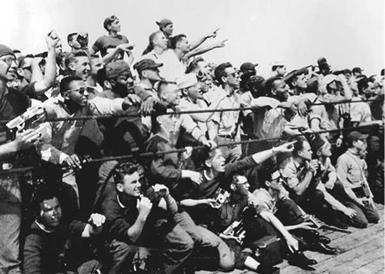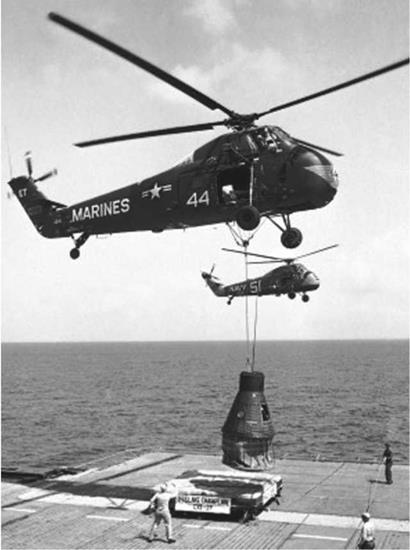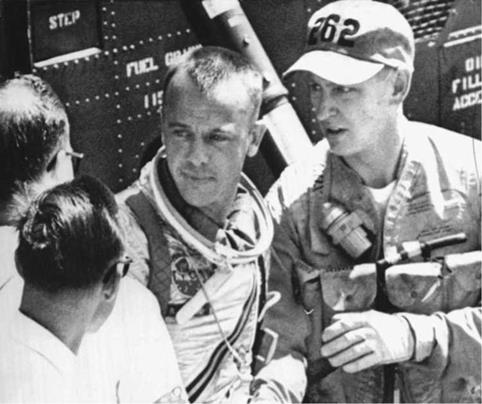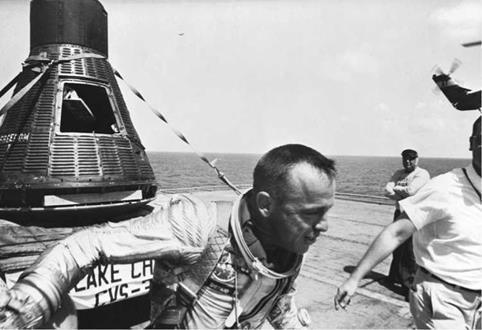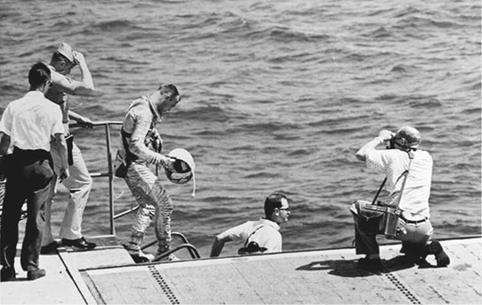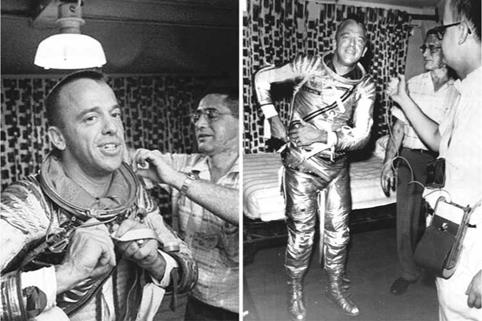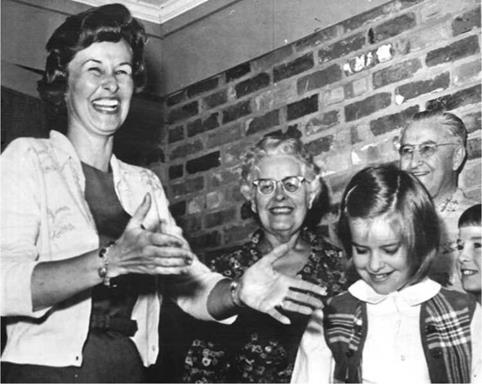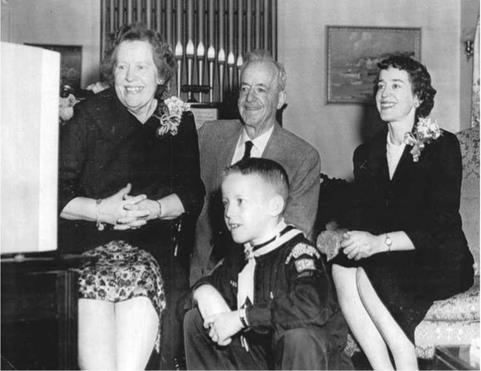WELCOME ABOARD, COMMANDER
George Cox remained on the Sikorsky’s lower deck with Shepard for the short flight back to the carrier. Within seven minutes of retrieving the spacecraft from the water, the helicopter was zeroing in on the USS Lake Champlain.
As Shepard later pointed out, “When we approached the ship, I could see sailors crowding the deck, applauding and cheering and waving their caps. I felt a real lump in my throat.” [32] He waved to the men as the pilots prepared to land.
|
The ship’s crew watched the entire recovery process with great excitement. (Photo courtesy of Larry Kreitzberg) |
On board “The Champ,” there was outstanding reason to celebrate, as related by Scott Thompson from Beaver Falls, Pennsylvania. First, there had been the sight of Freedom 7’s splashdown. “We knew about where to watch. We saw this little speck coming down from the sky. Then we saw the parachute open and float down. When the capsule hit the water, there was a lot of steam because it was so hot.” Soon after, an announcement blared out over the ship’s loudspeakers reporting that Shepard was okay, giving rise to loud cheers. “Everybody went crazy because they were so happy. They knew it was an historic event – the first U. S. man in space. They could have heard us a long way off. We made a lot of noise.” [33]
|
As Wayne Koons prepares to lower Freedom 7 onto the waiting platform, a Navy helicopter shadows the Marine helicopter, taking photographs. (Photo courtesy of Ed Killian) |
As in rehearsals, Koons carefully lowered Freedom 7 onto the specially prepared platform that had been cushioned with mattresses. On Cox’s command, he released the carrying hook. “The cargo hook could only be released by the pilot,” Koons says. “The basic hook design, installed on all Marine HUS helicopters, had two methods of release. The first method was electrical, actuated by a button on the pilot’s cyclic stick. The second method of release was mechanical, actuated by a foot pedal on the floor near the pilot’s right heel. For Mercury retrievals, the electrical circuitry was disconnected. A special latch was installed on the cargo hooks for Mercury retrieval work. This latch prevented opening the hook until it was released by a lever on the cyclic. After releasing the latch, the hook could be opened by the foot pedal.” [34]
Once the spacecraft had been safely situated on the platform and released, Koons set the helicopter down on the deck in front of 1,200 raucous sailors.
Freedom 7 had landed four nautical miles from where the USS Lake Champlain was stationed. The recorded departure time for the Marine helicopters that flew out to retrieve Shepard was 0927 (according to the OPNAV Part C record). Splashdown was at 0949, and the helicopter’s arrival back at the carrier was at 1000, a total of 33 minutes.
Koons has a particularly fond memory. “I was busy shutting the helicopter down and here Shepard in his silver suit minus the hard hat comes slithering up… through the space where George would have been if he were going to get up in his seat. He reached over and whacked me on the leg and [said], ‘Good boy.’ Then back down he went.” [35]
Another person on board that day, NASA representative Charles Tynan, also has a serendipitous recollection. Film cameras were able to document the flight of the helicopter which carried Shepard and Freedom 7 to a safe touchdown on the carrier, but “the Movietone News photographer later sent his movie film off the ship in a COD [cargo] aircraft and talked about possibly winning a Pulitzer Prize. I heard that shipboard personnel put a suicide watch on him when he found out his camera had malfunctioned and his film canister contained blank film.” [36] It was later rumored that the hapless fellow had filmed the entire operation but had failed to remove his lens cover.
NASA, meanwhile, had issued an updated press bulletin declaring, “Test No. 108 is terminated. This was the pioneer U. S. man-in-space flight. The Mercury spacecraft is on the deck of the aircraft carrier Lake Champlain and the helicopter is about to land. Shepard is about to come out of helicopter.” [37]
As the chopper was powered down, Navy physician Robert C. Laning and Army physician M. Jerome Strong approached and stood by the closed door. There was a moment or two of suspense before the door was suddenly flung open. George Cox climbed out, ready to assist the astronaut out of the helicopter, but he needn’t have bothered; Shepard jauntily leapt down to the deck. Only eleven minutes had elapsed since splashing into the ocean. Standing on the deck, Shepard shook hands with Cox and gave him a heartfelt, “Thank-you, very much.”
The magnitude of the welcome finally hit Shepard. “Until the moment I stepped out onto the flight deck of the carrier, I hadn’t realized the intensity of the emotions and feelings that so many people had for me, for the other astronauts, and the whole manned
|
As Shepard shakes hands with George Cox, the medical staff moves in to escort the astronaut to the admiral’s in-port cabin. (Photo courtesy of Dean Conger/NASA) |
space program. This was the first sense I had of public response, of a public expression of thanks for what we were doing. I was very close to tears.” [38]
According to the tight schedule, it was time for a medical checkup and to record a free-dictation report whilst the flight was still fresh in his mind. The two physicians approached, eager to escort Shepard to the admiral’s cabin, but there was one last distraction for America’s first astronaut. “I started for the quarters where the doctors would give me a quick once-over before I flew on to Grand Bahama Island for a full debriefing. But first I went back to the capsule, which had been gently lowered onto a pile of mattresses on the carrier’s deck. I wanted to retrieve the helmet that I’d left in the cockpit. And I wanted to take one more look at Freedom 7. I was pretty proud of the job that it had done too.” [39]
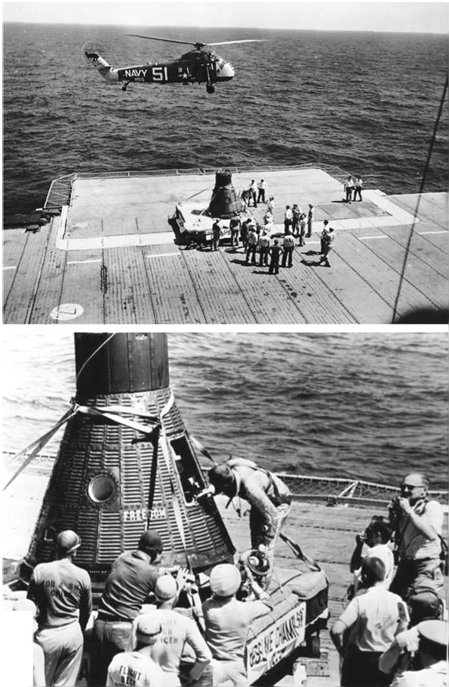 |
As the Navy helicopter hovers nearby, and much to the surprise of everyone present, Shepard returned briefly to Freedom 7 to fetch his helmet from the capsule. (Photos courtesy of Ed Killian)
|
|
Shepard, helmet in hand, is escorted below deck by Dr. Jerome Strong (partially obscured). (Photo courtesy of Dean Conger/NASA)
|
|
Dean Conger (right, with camera) records Shepard departing the flight deck. (Photo courtesy of Howard Skidmore)
Ed Buckbee, who would go on to become the first director of the U. S. Space and Rocket Center and the founder of Space Camp, both located in Huntsville, Alabama, was a public affairs officer for the space agency at the time of Shepard’s space shot. Some years later he asked the astronaut about climbing up and peering around the interior of his spacecraft. “Well, for one thing,” Shepard responded, “a fighter pilot never leaves his helmet in the cockpit, so I reached in to get my helmet. I also looked around the instrument panel to see if I turned everything off.” [40]
Shepard was then taken to the admiral’s in-port cabin, located just forward of the port side deck-edge elevator and accessed by a catwalk running along the edge of the flight deck. It was here that he would disrobe and have his biomedical leads removed prior to medical checks. “I don’t think you’re going to have much to do,” he told Dr. Laning with a wide grin as he consumed a refreshing glass of orange juice.
The priority task was to determine Shepard’s condition immediately after having undergone high acceleration forces at launch, weightlessness, and deceleration loads. It had been feared that even a few minutes of weightlessness might possibly cause a lingering disorientation and perhaps even affect an astronaut’s mind. But Shepard reported that he hardly realized when he had begun experiencing weightlessness, and his five minutes of zero-g proved to have left no trace of physiological or mental impairment. “It was painless,” he pointed out. “Just a pleasant ride.” He said the first real indication of being in a weightless state – he was tightly strapped in – was when a
|
As Shepard dictates his immediate reactions into a tape recorder, Dr. Laning and Dr. Strong assist him to remove his space suit and bio-med sensors. (Photos courtesy of Dean Conger/ NASA) |
stray washer floated by his left ear. In his opinion, having taken direct control of his spacecraft, an astronaut was fully capable of functioning freely in a weightless condition.
After this brief examination, the two doctors had to concur with Shepard’s earlier remark that they wouldn’t have much to do. Although he had arrived in the admiral’s cabin perspiring and with a high pulse rate, that had soon settled once he was finally able to relax. He was in his usual superb physical condition. A more detailed medical examination was to be made when he arrived later that day at Grand Bahama Island. With the tests done, Shepard dictated his remaining impressions of the flight into a tape recorder.
Meanwhile, there were mixed feelings of pride, joy and relief for his wife at their ranch-style home in Virginia Beach. Once she had composed herself, Louise went out onto the front porch and the waiting crowd of news reporters and photographers swarmed in to capture her mood in their notebooks and cameras. “I don’t have to tell you how I feel,” she said, with a wide, happy smile on her face. “It’s just wonderful. It’s beautiful… just wonderful.” [41]
|
An excited Louise Shepard on the porch of their Virginia Beach home after hearing of her husband’s recovery. She is accompanied by her parents, Mr. and Mrs. Russell Brewer, her niece Alice, and daughter Juliana. (Photo: Associated Press) |
|
In East Derry, New Hampshire, Alan Shepard’s parents, his sister Polly, and her son David, 10, are all smiles after news of his safe return to Earth. (Photo: United Press International) |
In Shepard’s hometown of East Derry, New Hampshire, the whole town exploded into a full-scale holiday. The streets were filled with rapturous people whooping and cheering and shaking hands with everyone they met, whilst church bells pealed out their glad tidings, fire engines wailed, and car horns added to the cacophony. There were calls for the town to be renamed “Spacetown, U. S.A.”











